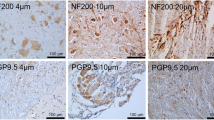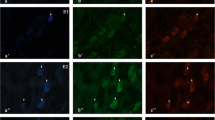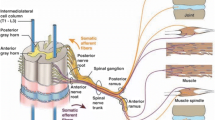Abstract
Purpose
In our aging society, the prevalence of degenerative spinal diseases rose drastically within the last years. However, up till now, the origin of cervical pain is incompletely understood. While animal and small cadaver studies indicate that a complex system of sensory and nociceptive nerve fibers in the anterior (ALL) and posterior longitudinal ligament (PLL) at the level of the intervertebral disc might be involved, there is a lack of data exploring whether such a network exists and is equally distributed within the cervical vertebrae (VB). We, therefore, aimed to investigate the spatial distribution of the mentioned nerve networks in human tissue.
Methods
We performed macroscopic (Sihler staining, Spalteholz technique, and Plastination) and microscopic (immunohistochemistry for PGP 9.5 and CGRP) studies to characterize spatial differences in sensory and nociceptive innervation patterns. Therefore, 23 human body donors were dissected from level C3–C6.
Results
We could show that there is a focal increase in sensory and nociceptive nerve fibers at the level of C4 and C5 for both ALL and PLL, while we observed less nerve fiber density at the level of C3 and C6. An anatomical vicinity between nerve and vessels was observed.
Conclusion
To our knowledge, these findings for the first time report spatial differences in sensory and nociceptive nerve fibers in the human cervical spine at VB level. The interconnection between nerves and vessels supports the importance of the perivascular plexus. These findings might be of special interest for clinical practice as many patients suffer from pain after cervical spine surgery.







Similar content being viewed by others
References
Adogwa O, Elsamadicy AA, Vuong VD et al (2018) Immediate postoperative pain scores predict neck pain profile up to 1 year following anterior cervical discectomy and fusion. Global Spine J 8:231–236. https://doi.org/10.1177/2192568217706700
Avila MJ, Skoch J, Sattarov K, Abbasi Fard S, Patel A, Walter CM, Baaj AA (2015) Posterior longitudinal ligament resection or preservation in anterior cervical decompression surgery. J Clin Neurosci 22:1088–1090. https://doi.org/10.1016/j.jocn.2015.01.021
Benemei S, Nicoletti P, Capone JG, Gepetti P (2009) CGRP receptors in the control of pain and inflammation. Curr Opin Pharmacol 9:9–14. https://doi.org/10.1016/j.coph.2008.12.007
Bogduk N, Windsor M, Inglis A (1988) The innervation of the cervical intervertebral discs. Spine 13:2–8
Coderre TJ, Bennett GJ (2010) A hypothesis for the cause of complex regional pain syndrome-type I (reflex sympathetic dystrophy): pain due to deep-tissue microvascular pathology. Pain Med 11:1224–1238. https://doi.org/10.1111/j.1526-4637.2010.00911.x
Cohen SP (2015) Epidemiology, diagnosis, and treatment of neck pain. Mayo Clin Proc 90:284–299. https://doi.org/10.1016/j.mayocp.2014.09.008
Dodick DW, Goadsby PJ, Silberstein SD et al (2014) Safety and efficacy of ALD403, an antibody to calcitonin gene-related peptide, for the prevention of frequent episodic migraine: a randomised, double-blind, placebo-controlled, exploratory phase 2 trial. Lancet Neurol 13:1100–1107. https://doi.org/10.1016/S1474-4422(14)70209-1
Falco FJE, Datta S, Manchikanti L, Sehgal N, Geffert S, Singh V, Smith HS, Boswell MV (2012) An updated review of the diagnostic utility of cervical facet joint injections. Pain Phys 15:E807–E838
Grimmer A, Wurm G (2010) Chirurgische Strategien bei Bandscheibenvorfällen an der Halswirbelsäule. J Neurol Neurosurg Psychiatry 12:23–30
Grob D, Frauenfelder H, Mannion AF (2007) The association between cervical spine curvature and neck pain. Eur Spine J 16:669–678. https://doi.org/10.1007/s00586-006-0254-1
Groen GJ, Baljet B, Drukker J (1988) The innervation of the spinal dura mater: anatomy and clinical implications. Acta Neurochir 92:39–46. https://doi.org/10.1007/BF01401971
Imai S, Konttinen YT, Tokunaga Y et al (1997) Tyrosine hydroxylase-immunoreactive nerve fibres in rat posterior longitudinal ligament. J Auton Nerv Syst 63:51–60. https://doi.org/10.1016/S0165-1838(96)00130-0
Kallakuri S, Singh A, Chen C, Cavanaugh JM (2004) Demonstration of Substance P, calcitonin gene-related peptide, and protein gene product 9.5 containing nerve fibers in human cervical facet joint capsules. Spine 29:1182–1186. https://doi.org/10.1097/00007632-200406010-00005
Kojima Y, Maeda T, Arai R, Shichikawa K (1990) Nerve supply to the posterior longitudinal ligament and the intervertebral disc of the rat vertebral column as studied by acetylcholinesterase histochemistry. II. Regional differences in the distribution of the nerve fibres and their origins. J Anat 169:247–255
Kokubo Y, Uchida K, Kobayashi S et al (2008) Herniated and spondylotic intervertebral discs of the human cervical spine: histological and immunohistological findings in 500 en bloc surgical samples. J Neurosurg Spine 9:285–295. https://doi.org/10.3171/SPI/2008/9/9/285
Li J, Gu T, Yang H, Liang L, Jiang D, Wang Z, Yuan W, Wang X (2014) Sympathetic nerve innervation in cervical posterior longitudinal ligament as a potential causative factor in cervical spondylosis with sympathetic symptoms and preliminary evidence. Med Hypotheses 82:631–635. https://doi.org/10.1016/j.mehy.2014.02.029
Marchi L, Oliveira L, Coutinho E, Pimenta L (2012) The importance of the anterior longitudinal ligament in lumbar disc arthroplasty: 36-month follow-up experience in extreme lateral total disc replacement. Int J Spine Surg 6:18–23. https://doi.org/10.1016/j.ijsp.2011.09.002
Mu L, Sanders I (1998) Neuromuscular specializations of the pharyngeal dilator muscles: I. Compartments of the canine geniohyoid muscle. Anat Rec (Hoboken) 250:146–153
Mu L, Sanders I (1999) Neuromuscular organization of the canine tongue. Anat Rec (Hoboken) 256:412–424
Peng B, Bogduk N (2019) Cervical discs as a source of neck pain. An analysis of the evidence. Pain Med 20:446–455. https://doi.org/10.1093/pm/pny249
Pieroh P, Koch M, Wagner D-C, Boltze J, Ehrlich A, Ghadban C, Hobusch C, Birkenmeier G, Dehghani F (2014) Temporal dynamics of glyoxalase 1 in secondary neuronal injury. PLoS One 9:e87364. https://doi.org/10.1371/journal.pone.0087364
Sample SJ, Hao Z, Wilson AP, Muir P (2011) Role of calcitonin gene-related peptide in bone repair after cyclic fatigue loading. PLoS ONE 6:e20386. https://doi.org/10.1371/journal.pone.0020386
Steinke H (2001) Plastinated body slices for verification of magnetic resonance tomography images. Ann Anat 183:275–281. https://doi.org/10.1016/S0940-9602(01)80234-X
Steinke H, Wolff W (2001) A modified Spalteholz technique with preservation of the histology. Ann Anat 183:91–95. https://doi.org/10.1016/S0940-9602(01)80020-0
Tasiou A, Giannis T, Brotis AG, Siasios I et al (2017) Anterior cervical spine surgery-associated complications in a retrospective case–control study. J Spine Surg 3:444–459. https://doi.org/10.21037/jss.2017.08.03
Wang MC, Chan L, Maiman DJ, Kreuter W, Deyo RA (2007) Complications and mortality associated with cervical spine surgery for degenerative disease in the united states. Spine 32:342–347. https://doi.org/10.1097/01.brs.0000254120.25411.ae
World Health Organization (2015) World report on ageing and health 2015. https://www.who.int/ageing/events/world-report-2015-launch/en/. Accessed Jan 2019
Wyke B (1970) The neurological basis of thoracic spinal pain. Rheumatology (Oxford) 10:356–359
Yamada H, Honda T, Yaginuma H, Kikuchi S, Sugiura Y (2001) Comparison of sensory and sympathetic innervation of the dura mater and posterior longitudinal ligament in the cervical spine after removal of the stellate ganglion. J Comp Neurol 434:86–100. https://doi.org/10.1002/cne.1166
Youssef P, Loukas M, Chapman JR, Oskouian RJ, Tubbs RS (2016) Comprehensive anatomical and immunohistochemical review of the innervation of the human spine and joints with application to an improved understanding of back pain. Childs Nerv Syst 32:243–251. https://doi.org/10.1007/s00381-015-2880-6
Acknowledgements
We thank Charlotte Kulow for reading the manuscript as a native speaker. We also thank Isabel N. Schellinger and Marco Kuhlen. This research was funded by Landeszuwendung of SMWK (Saxonian Ministry of Science and Art).
Funding
This research was funded by Landeszuwendung of SMWK (Saxonian Ministry of Science and Art, 100096796).
Author information
Authors and Affiliations
Contributions
TS: dissection, histological and immunohistochemical staining, data collection, data analysis, and manuscript writing. HS: project development and manuscript writing. PP: protocol development, advice in histology and immunohistochemistry, and manuscript editing. FD: advice in histology and immunohistochemistry. AV: clinical advice and spinal surgeon. MJG: clinical advice and neurosurgeon. TW: dissection. MW: biomechanical advice. JK: protocol development and immunohistochemistry. AH: data analysis/management. ML: project development and manuscript editing.
Corresponding author
Ethics declarations
Conflict of interest
The authors declare that they have no conflict of interest.
Additional information
Publisher's Note
Springer Nature remains neutral with regard to jurisdictional claims in published maps and institutional affiliations.
Electronic supplementary material
Below is the link to the electronic supplementary material.
Online Fig.
1: Comorbidities of the body donors are given in this table. Hypertension and the history of carcinoma have been most prevalent. Diabetes or smoking have not been so frequent. (PPTX 40 kb)
Online Table
1: Mean age and ICD-code numbers off all body donors which were used for immunohistochemistry. (PPTX 149 kb)
Online Table
2: This table gives an overview of how many cervical columns have been dissected and how many probes and following slices were stained. This is the base to calculate the relative frequencies for the certain segment and ligament. (PPTX 149 kb)
Online Table
3. In this table are the positive numbers of immunoreactive slices for each gender related to the total number of observed slices (number in brackets) for each cervical level. The relative frequencies have not shown any main differences between male or female tissue. (PPTX 51 kb)
Rights and permissions
About this article
Cite this article
Stegmann, T., Steinke, H., Pieroh, P. et al. On the importance of the innervation of the human cervical longitudinal ligaments at vertebral level. Surg Radiol Anat 42, 127–136 (2020). https://doi.org/10.1007/s00276-019-02316-6
Received:
Accepted:
Published:
Issue Date:
DOI: https://doi.org/10.1007/s00276-019-02316-6




